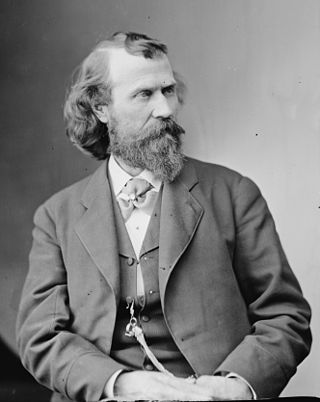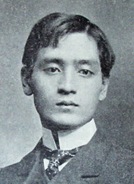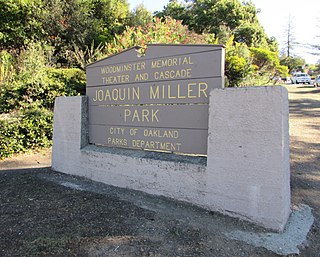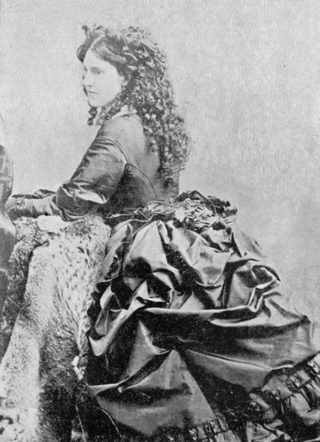
Cincinnatus Heine Miller, better known by his pen name Joaquin Miller, was an American poet, author, and frontiersman. He is nicknamed the "Poet of the Sierras" after the Sierra Nevada, about which he wrote in his Songs of the Sierras (1871).

Isamu Noguchi was an American artist and landscape architect whose artistic career spanned six decades, from the 1920s onward. Known for his sculpture and public artworks, Noguchi also designed stage sets for various Martha Graham productions, and several mass-produced lamps and furniture pieces, some of which are still manufactured and sold.

Bernard Ralph Maybeck was an American architect in the Arts and Crafts Movement of the early 20th century. He was an instructor at University of California, Berkeley. Most of his major buildings were in the San Francisco Bay Area.

The John Muir National Historic Site is located in the San Francisco Bay Area, in Martinez, Contra Costa County, California. It preserves the 14-room Italianate Victorian mansion where the naturalist and writer John Muir lived, as well as a nearby 325-acre tract of native oak woodlands and grasslands historically owned by the Muir family. The main site is on the edge of town, in the shadow of State Route 4, also known as the "John Muir Parkway."

The Rancho San Andrés Castro Adobe is a historically and architecturally significant house located in the Pájaro Valley, California. The two-story Rancho San Andrés Castro Adobe is a historic rancho hacienda that was built between 1848 and 1849.

Colonel Allensworth State Historic Park is a state park unit of California, United States, preserving Allensworth, the only California town to be founded, financed and governed by African Americans. The small farming community was founded in 1908 by Lt. Colonel Allen Allensworth, Professor William Payne, William Peck, a minister; John W. Palmer, a miner; and Harry A. Mitchell, a real estate agent, dedicated to improving the economic and social status of African Americans. Colonel Allensworth (1842–1914) had a friendship with Booker T. Washington and was inspired by the Tuskegee Institute and development in its neighboring town. Allensworth hoped to develop the "Tuskegee of the West".
Rancho San Antonio, also known as the Peralta Grant, was a 44,800-acre (181 km2) land grant by Governor Pablo Vicente de Solá, the last Spanish governor of California, to Don Luís María Peralta, a sergeant in the Spanish Army and later, commissioner of the Pueblo of San José, in recognition of his forty years of service. The grant, issued on August 3, 1820, embraced the sites of the cities of San Leandro, Oakland, Alameda, Emeryville, Piedmont, Berkeley, and Albany.

Yonejirō Noguchi was an influential Japanese writer of poetry, fiction, essays and literary criticism in both English and Japanese. He is known in the west as Yone Noguchi. He was the father of noted sculptor Isamu Noguchi.

Miriam Leslie was an American publisher and author. She was the wife of Frank Leslie and the heir to his publishing business, which she developed into a paying concern from a state of precarious indebtedness. After her husband's death, she changed her own name to his, Frank Leslie. She made Carrie Chapman Catt a residuary legatee of her estate, to support enfranchising women. The activist established the Leslie Woman Suffrage Commission for this purpose.

The American Diary of a Japanese Girl is the first English-language novel published in the United States by a Japanese writer. Acquired for Frank Leslie's Illustrated Monthly Magazine by editor Ellery Sedgwick in 1901, it appeared in two excerpted installments in November and December of that year with illustrations by Genjiro Yeto. In 1902, it was published in book form by the New York firm of Frederick A. Stokes. Marketed as the authentic diary of an 18-year-old female visitor to the United States named "Miss Morning Glory" (Asagao), it was in actuality the work of Yone Noguchi, who wrote it with the editorial assistance of Blanche Partington and Léonie Gilmour.

Jack London State Historic Park, also known as Jack London Home and Ranch, is a California State Historic Park near Glen Ellen, California, United States, situated on the eastern slope of Sonoma Mountain. It includes the ruins of a house burned a few months before Jack London and family were to move in, a cottage in which they had lived, another house built later, and the graves of Jack London and his wife. The property is both a California Historical Landmark and a National Historic Landmark.

Joaquin Miller Park is a large open space park in the Oakland Hills owned and operated by the city of Oakland, California. It is named after early California writer and poet Joaquin Miller, who bought the land in the 1880s, naming it "The Hights" [sic], and lived in the house preserved as the Joaquin Miller House.
Miller House may refer to:

Sequoyah's Cabin is a log cabin and historic site off Oklahoma State Highway 101 near Akins, Oklahoma. It was the home between 1829 and 1844 of the Cherokee Indian Sequoyah, who in 1821 created a written language for the Cherokee Nation. The cabin and surrounding park was declared a National Historic Landmark in 1965 and is now owned by the Cherokee Nation.

This is a list of the National Register of Historic Places listings in Alameda County, California.

The Joaquin Miller Cabin is an historic structure situated in Washington, DC's Rock Creek Park. Built by the American poet, essayist and fabulist Joaquin Miller, it represents the only known example of late 19th century Rustic-style log cabin in Washington, D.C. It is a Classified Structure within Rock Creek Park.

Blanche Partington was a prominent San Francisco journalist and member of the San Francisco Bay Area literary and cultural scene. She is particularly noted for her relationships with prominent California writers, including Ambrose Bierce, Jack London, and Yone Noguchi.

The Yosemite Village Historic District encompasses the primary built-up section of the Yosemite Valley as it was developed by the National Park Service for Yosemite National Park. The district includes visitor services areas, park personnel residences and administrative facilities. It is located to the north of the Merced River. The district includes the National Historic Landmark Rangers' Club.

The Moraga Adobe is located at 24 Adobe Lane in Orinda, California. It was built by Don Joaquin Moraga who was the grandson of Jose Joaquin Moraga an early Spanish explorer in California who founded the city of San Jose, California. In 1835, Mexico granted 13,326 acres (5,393 ha), El Rancho Laguna de los Palos Colorados, to Joaquin Moraga and his cousin Juan Bernal. Six years later in 1841, Joaquin built this house, which is the oldest of the five surviving adobe houses in Contra Costa County. The adobe sits on a knoll at the center of the 20-acre (8.1 ha) property of what is left of the original land grant. The house has been restored and remodeled twice since it was photographed for HABS, first in 1941 when Katharine Brown White Irvine of Oakland, California purchased the old adobe, making additions such as adding three bedrooms and a veranda, and covering the adobe walls and again in 1964 when it was incorporated into a private home. The house is not accessible to the public and it is fenced off. However, it was photographed in 1922 for the Historical American Building Survey (HABS). Today, the Moraga Adobe is privately owned and unoccupied. The overall condition of the original adobe section and the more modern addition is neglected, but the building appears sound. The surrounding property was recently purchased, and the new owners have boarded up the windows to prevent vandalism and trespassing. The Moraga Adobe has been designated as a Historical Landmark by the City of Orinda and the State of California. A campaign has been started to purchase the property and restore the house to its 1848 configuration, to be used as a museum and educational site.

Theresa Dyer, better known by her pen names, Minnie Myrtle and Minnie Myrtle Miller, was an American author of prose and verse. She was a frequent contributor to the newspapers under her pen name, "Minnie Myrtle" before her marriage to Joaquin Miller, and "Minnie Myrtle Miller" thereafter.
























